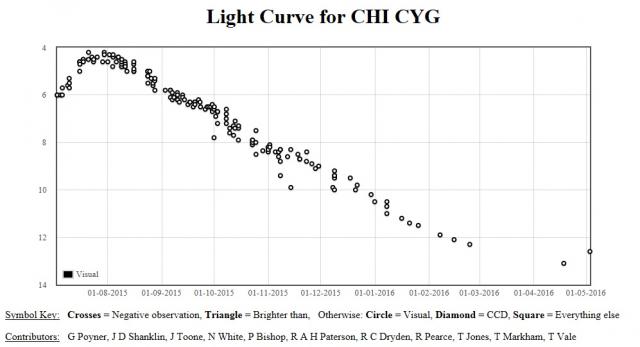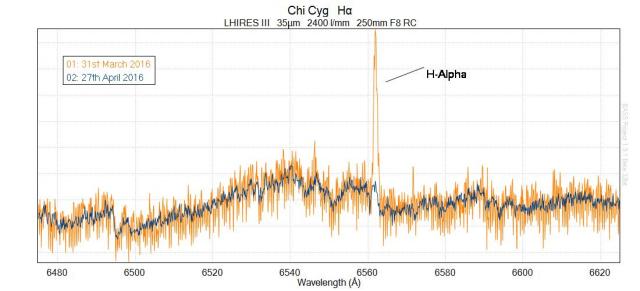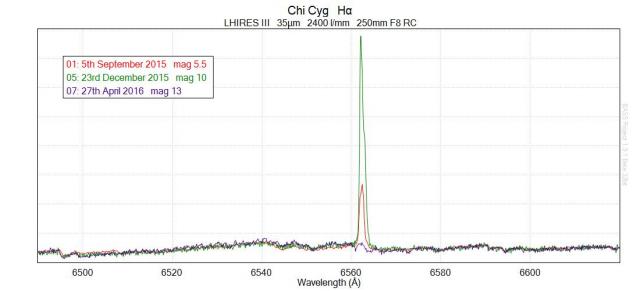› Forums › Spectroscopy › Spectra of chi Cygni near minimum
- This topic has 7 replies, 4 voices, and was last updated 9 years, 8 months ago by
 Andy Wilson.
Andy Wilson.
-
AuthorPosts
-
4 May 2016 at 9:23 pm #573562
 Andy WilsonKeymaster
Andy WilsonKeymasterThe Mira type variable star chi Cygni has just passed through its minimum in March / April of this year, as can be seen from the below light curve from the BAA VSS online database.

I was able to obtain high resolution H-alpha spectra at around minimum on 31st March, and after minimum on 27th April. The March spectrum is rather noisy as I had to cut it short due to twighlight, but the H-alpha emission line can still be clearly seen. In my follow up spectrum from 27th April the emission line has almost completely gone. I’m rather pleased with these spectra as they were obtained when the star was about magnitude 13, which is far fainter than I thought I could go with my setup, though I do pay for it with long exposures and I still get a noisy spectrum.

To show the evolution of the H-alpha emission line here is a plot of 3 spectra overlaid, from just after maximum, to half way through the decline, to just after minimum. The spectra are not flux calibrated, so you should not read too much into the the relative intensities of the emission line and the continuum.

As the spectra were taken on different dates and times, they have all been heliocentric corrected. This removes the doppler shift to the wavelength created by the Earth’s rotation and orbit around the Sun.
Andy
4 May 2016 at 11:33 pm #577336 Bill WardParticipant
Bill WardParticipantHi,
That’s a terrific piece of work. A dramatic demonstration of stellar spectroscopy.
You mention the long exposures, working at mag +13 what length were they? I’ve built several fairly crude spectroscopes over the years but I was drooling over the multitude of very neat commercial devices that were on show at the Astrofest! I’m tempted to put one on my C9.25….
cheers,
Bill.
5 May 2016 at 12:02 am #577338 Andy WilsonKeymaster
Andy WilsonKeymasterHi Bill,
They were actually not that long compared to some deep sky imagers. The 27th April spectrum was from a 1 hour exposure, made up of 6 x 10 minutes. For some targets I’ve gone out to 2 hours and I would have liked to have done that or more for chi Cyg but there is a limit to how late I can stay up until with work the next day.
I suspect chi Cyg is a little easier than some mag 13 stars, as that is a V filter magnitude. It is a very red star, and even more red at minumum, so there will be more light around H-alpha which is in the red part of the spectrum. Also, whenever there is an H-alpha emission line, then it is easier to get a good signal on a faint star, as a lot of light is concentrated in a narrow emission line.
Cheers,
Andy
5 May 2016 at 1:21 am #577339 Steve CuthbertParticipant
Steve CuthbertParticipantExcellent work Andy. Might give Chi Cyg a try with my Alpy & 120mm Espirit but mag 13 might be pushing it a bit 😉
regards
Steve
5 May 2016 at 7:37 am #577340 Andy WilsonKeymaster
Andy WilsonKeymasterHi Steve,
I think chi Cyg near minimum would make an excellent challenge for the Alpy, and it is only getting brighter. You would be able to see how the whole of the spectrum changes rather than just H-alpha.
A quick back of the envelope calculation. Your refractor has about a quarter of the light gather power of my RC. However, if I make the assumption that I can use resolution as an approximation to how dispersed the spectrum is across the chip (lots of assumptions..). My Lhires III has approximately 20 times the resolution of your Alpy, so you should get a spectrum that is about 20x brighter. So overall you might get 4-5x the intensity that I do. This is of course a very rough calculation, and it also assumes we get a similar throughput through the spectrograph slit, which is affected by a number of factors. I used my widest slit at 35 micrometers.
Thanks,
Andy
5 May 2016 at 2:12 pm #577341 Robin LeadbeaterParticipant
Robin LeadbeaterParticipantHi Andy,
It looks like your optimisation is paying dividends. My limit at H alpha for verifying faint Be stars was around Vmag 10 with the LHIRES 2400 and C11, though these were much bluer stars of course.
Steve,
I think mag13 should be doable with your setup too. I’ve not tested the limit of my ALPY in 600 form but for example doing the same back of envelope calculation from the other end with my modified ALPY 200, I can get to mag 17, where sky background becomes an issue. The resolution of the ALPY 600 is ~4x higher and your aperture area is ~1/3 of mine giving a 12x factor overall or ~2-3 mags
Cheers
Robin
7 May 2016 at 8:07 am #577343 Andy WilsonKeymaster
Andy WilsonKeymasterHi Robin,
I expect that observing a very red star made a big difference in how faint I could go. I could not find any R magitude measurements but I’m sure it would have been brighter than 13th mag through an R filter.
There is also of course a difference between obtaining a high quality spectrum, and simply looking for a detection of whether or not H-alpha is in emission. My next challenge will be to learn to flux calibrate my spectra, so I can properly analyse the intensity changes for a future cycle of chi Cyg.
Best wishes,
Andy
7 May 2016 at 8:20 am #577344 Andy WilsonKeymaster
Andy WilsonKeymasterMy browser was playing up and I’ve removed a duplication of my previous comment.
-
AuthorPosts
- You must be logged in to reply to this topic.
